2014 MERCEDES-BENZ CLS COUPE child restraint
[x] Cancel search: child restraintPage 10 of 417

Care
Automatic car wash ...................... .334
Carpets .......................................... 341
Display .......................................... .339
Exhaust pipe .................................. 338
Exterior lighting ............................ .337
Gear or selector lever .................... 340
High-pressure cleaner .................... 335
Interior .......................................... .339
Matt paintwork .............................. 336
Night View Assist Plus ................... 339
Notes ............................................. 334
Paint .............................................. 336
Plastic trim ................................... .339
Reversing camera .......................... 338
Roof lining ...................................... 341
Seat belt ........................................ 340
Seat cover ..................................... 340
Sensors ......................................... 337
Steering wheel ............................... 340
Trim pieces ................................... .340
Washing by hand ........................... 335
Wheels .......................................... .336
Windows ........................................ 337
Wiper blades .................................. 337
Wooden load compartment floor ... 341
Wooden trim .................................. 340
CD player/CD changer(on-board
computer) .......................................... 246
Central locking
Automatic locking (on-board com-
puter) ............................................. 255
Locking/unlocking (key ).................. 83
Centre console
Lower section .................................. 37
Lower section (AMG vehicles) .......... 38
Upper section .................................. 36
Changing bulbs
Reversing lamps ............................ 132
Child seat
Automatic recognition ..................... 59
Forward-facing restraint system ...... 62
ISOFIX .............................................. 57
On the front-passenger sea t............ 61
Problem (malfunction) ..................... 63
Rearward-facing restraint system .... 62
Recommendations ........................... 66
Suitable positions ............................ 63 Top Tether ....................................... 57
Child-proof locks
Important safety notes .................... 68
Rear doors ....................................... 69
Children
Restraint systems ............................ 56
Cigarette lighter ................................ 317
Cleaning
Mirror turn signal ........................... 337
Trailer tow hitch ............................. 338
Climate control
Auxiliary heating/ventilation .......... 150
Controlling automaticall y............... 144
Convenience opening/closing
(air-recirculation mode) ................. 148
Cooling with air dehumidification .. 143
Demisting the windows .................. 147
Demisting the windscreen ............. 146
Important safety notes .................. 138
Indicator lamp ................................ 144
Information about using
THERMATIC automatic climate
control ........................................... 139
Information on using
THERMOTRONIC automatic cli-
mate control .................................. 142
Overview of systems ...................... 138
Problem with the rear window
heating .......................................... 148
Problems with cooling with air
dehumidification ............................ 144
Rear control panel ......................... 141
Setting the air distribution ............. 145
Setting the air vents ...................... 154
Setting the airflow ......................... 146
Setting the climate mode (AIR
FLOW) ............................................ 144
Setting the temperature ................ 145
Setting the temperature,
THERMATIC ................................... 145
Setting the temperature,
THERMOTRONIC ............................ 145
Switching air-recirculation mode
on/of f............................................ 148
Switching on/of f........................... 142
Switching residual heat on/off ...... 149
Switching the rear window heat-
ing on/of f...................................... 147 Index
7
Page 18 of 417
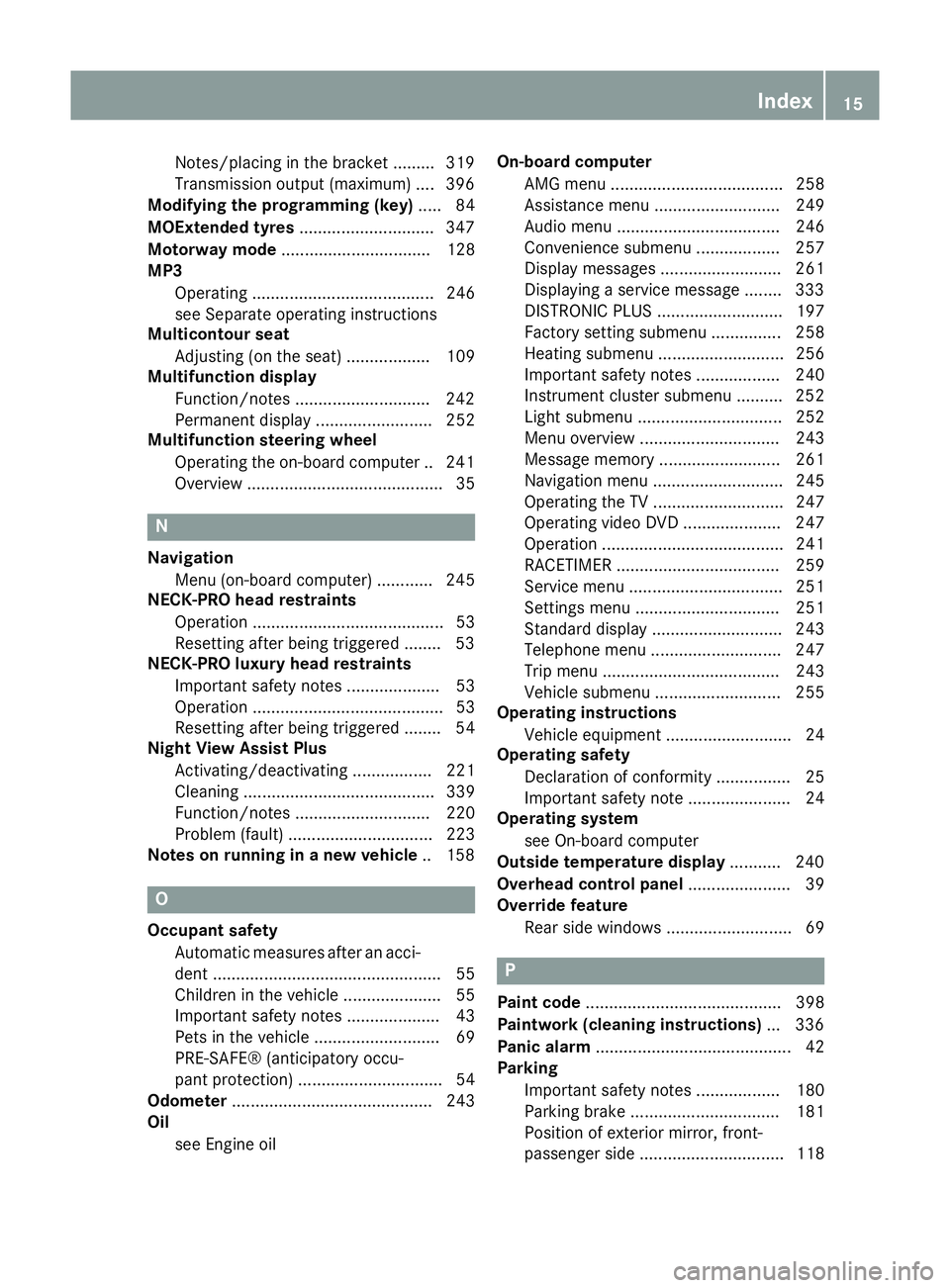
Notes/placing in the bracket .........3
19
Transmission output (maximum) .... 396
Modifying the programming (key) ..... 84
MOExtended tyres .............................347
Motorway mode ................................ 128
MP3
Operating ....................................... 246
see Separate operating instructions
Multicontour seat
Adjusting (on the seat) .................. 109
Multifunction display
Function/notes ............................ .242
Permanent display ......................... 252
Multifunction steering wheel
Operating the on-board computer .. 241
Overview .......................................... 35 N
Navigation Menu (on-board computer) ............ 245
NECK-PRO head restraints
Operation ......................................... 53
Resetting after being triggered ....... .53
NECK-PRO luxury head restraints
Important safety note s.................... 53
Operation ......................................... 53
Resetting after being triggered ........ 54
Night View Assist Plus
Activating/deactivating ................. 221
Cleaning ......................................... 339
Function/note s............................. 220
Problem (fault) ............................... 223
Notes on running in a new vehicle .. 158O
Occupant safety Automatic measures after an acci-
dent ................................................. 55
Children in the vehicle ..................... 55
Important safety notes .................... 43
Pets in the vehicle ........................... 69
PRE-SAFE® (anticipatory occu-
pant protection) ............................... 54
Odometer ........................................... 243
Oil
see Engine oil On-board computer
AMG menu ..................................... 258
Assistance menu ........................... 249
Audio menu ................................... 246
Convenience submenu .................. 257
Display messages .......................... 261
Displaying a service message ........ 333
DISTRONIC PLUS ........................... 197
Factory setting submenu ............... 258
Heating submenu ........................... 256
Important safety notes .................. 240
Instrument cluster submenu .......... 252
Light submenu ............................... 252
Menu overview .............................. 243
Message memory .......................... 261
Navigation menu ............................ 245
Operating the TV ............................ 247
Operating video DVD ..................... 247
Operation ....................................... 241
RACETIMER ................................... 259
Service menu ................................. 251
Settings menu ............................... 251
Standard display ............................ 243
Telephone menu ............................ 247
Trip menu ...................................... 243
Vehicle submenu ........................... 255
Operating instructions
Vehicle equipment ........................... 24
Operating safety
Declaration of conformity ................ 25
Important safety note ...................... 24
Operating system
see On-board computer
Outside temperature display ........... 240
Overhead control panel ...................... 39
Override feature
Rear side window s........................... 69 P
Paint code .......................................... 398
Paintwork (cleaning instructions) ... 336
Panic alarm .......................................... 42
Parking
Important safety notes .................. 180
Parking brake ................................ 181
Position of exterior mirror, front-
passenger side ............................... 118 Index
15
Page 20 of 417
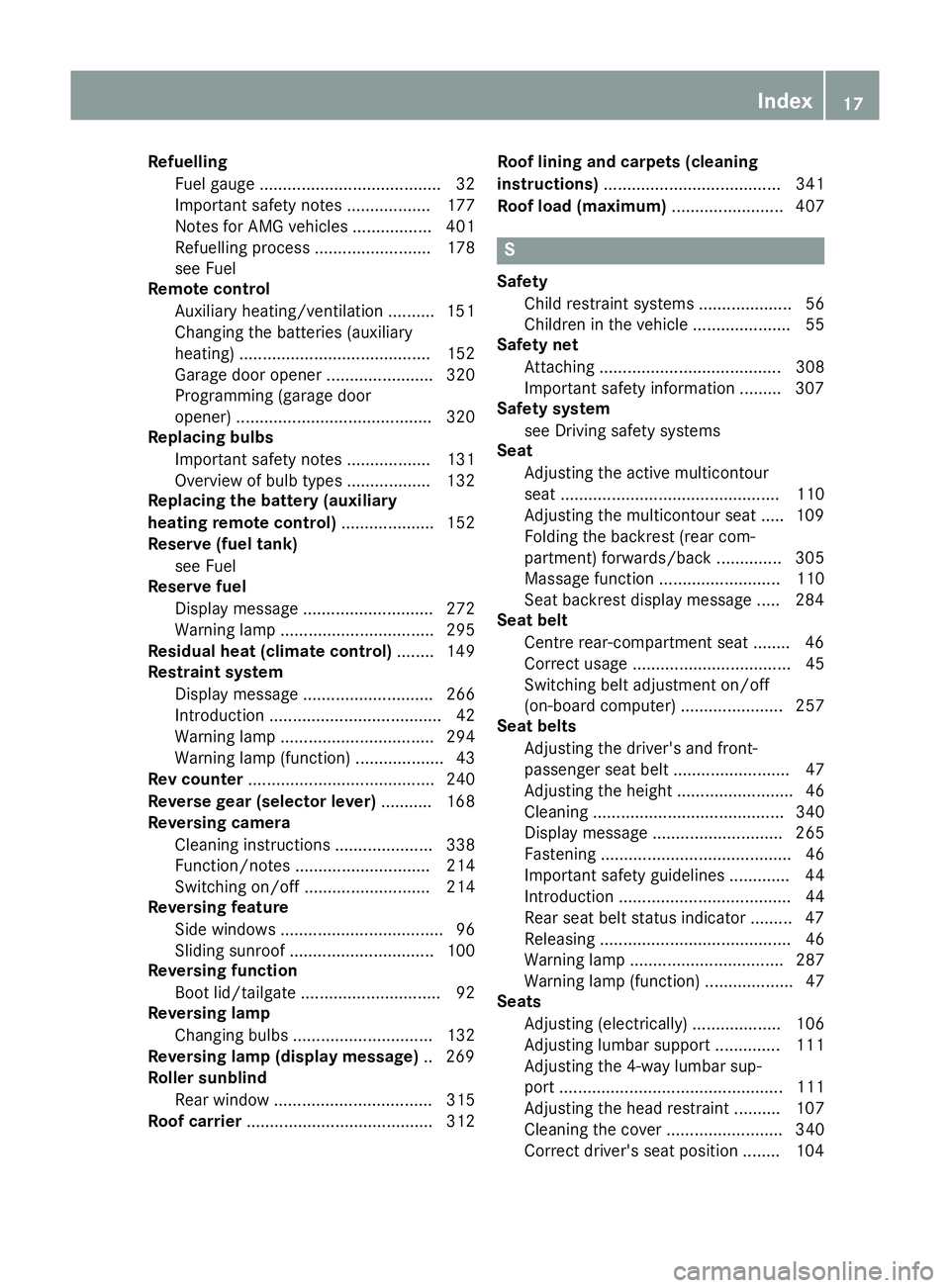
Refuelling
Fuel gaug e....................................... 32
Important safety notes .................. 177
Notes for AMG vehicles ................. 401
Refuelling process ......................... 178
see Fuel
Remote control
Auxiliary heating/ventilation .......... 151
Changing the batteries (auxiliary
heating) ......................................... 152
Garage door opener ....................... 320
Programming (garage door
opener) .......................................... 320
Replacing bulbs
Important safety notes .................. 131
Overview of bulb types .................. 132
Replacing the battery (auxiliary
heating remote control) .................... 152
Reserve (fuel tank)
see Fuel
Reserve fuel
Display message ............................ 272
Warning lamp ................................. 295
Residual heat (climate control) ........ 149
Restraint system
Display message ............................ 266
Introduction ..................................... 42
Warning lamp ................................. 294
Warning lamp (function) ................... 43
Rev counter ........................................ 240
Reverse gear (selector lever) ........... 168
Reversing camera
Cleaning instructions ..................... 338
Function/note s............................. 214
Switching on/of f........................... 214
Reversing feature
Side windows ................................... 96
Sliding sunroof ............................... 100
Reversing function
Boot lid/tailgate .............................. 92
Reversing lamp
Changing bulb s.............................. 132
Reversing lamp (display message) .. 269
Roller sunblind
Rear window .................................. 315
Roof carrier ........................................ 312 Roof lining and carpets (cleaning
instructions)
...................................... 341
Roof load (maximum) ........................ 407 S
Safety Child restraint systems .................... 56
Children in the vehicle ..................... 55
Safety net
Attaching ....................................... 308
Important safety information ......... 307
Safety system
see Driving safety systems
Seat
Adjusting the active multicontour
seat ............................................... 110
Adjusting the multicontour seat ..... 109
Folding the backrest (rear com-
partment) forwards/back .............. 305
Massage function .......................... 110
Seat backrest display message ..... 284
Seat belt
Centre rear-compartment sea t........ 46
Correct usage .................................. 45
Switching belt adjustment on/off
(on-board computer) ...................... 257
Seat belts
Adjusting the driver's and front-
passenger seat belt ......................... 47
Adjusting the height ......................... 46
Cleaning ......................................... 340
Display message ............................ 265
Fastening ......................................... 46
Important safety guidelines ............. 44
Introduction ..................................... 44
Rear seat belt status indicator ......... 47
Releasing ......................................... 46
Warning lamp ................................. 287
Warning lamp (function) ................... 47
Seats
Adjusting (electrically) ................... 106
Adjusting lumbar support .............. 111
Adjusting the 4-way lumbar sup-
port ................................................ 111
Adjusting the head restraint .......... 107
Cleaning the cover ......................... 340
Correct driver's seat position ........ 104 Index
17
Page 45 of 417

Useful information
i This Owner's Manual describes all mod-
els, series and optional equipment for your
vehicle that were available at the time of
going to press. National variations are pos- sible. Note that your vehicle may not be
equipped with all of the functions descri-
bed. This is also the case for systems and
functions relevant to safety.
i Read the information on qualified special-
ist workshops: (Y page 26). Panic alarm
X
To activate: press!button :for
approximately one second.
An alarm sounds and the exterior lighting
flashes.
X To deactivate: press!button :
again.
or
X Insert the key into the ignition lock.
or X Press the KEYLESS-GO Start/Stop button.
The KEYLESS-GO key must be in the vehi-
cle.
i The panic alarm function is only available
in certain countries. Occupant safety
Introduction to the restraint system
The restraint system reduces the risk of vehi- cle occupants coming into contact with parts
of the vehicle's interior in the event of an
accident. Furthermore, the restraint system
can also reduce the forces to which vehicle
occupants are subjected during an accident.
The restraint system includes:
R Seat belt system
R Airbags
R Child restraint system
R Child seat securing system
The various components of the restraint sys-
tem work complementary to one another. It
can only provide maximum protection if all
vehicle occupants:
R have their seat belt correctly fastened
(Y page 45)
R have correctly adjusted their seat and head
restraint (Y page 105).
As the driver, you must also ensure that the
steering wheel is correctly adjusted. Observe
the information relating to the correct driver's
seat position (Y page 104).
Additionally, you must ensure that an airbag
can deploy freely (Y page 48).
An airbag is supplementary to a correctly fas- tened seatbelt and, as an additional safety
device, provides greater protection for vehi-
cle occupants in an accident situation. If the
protection provided by the seat belt is suffi-
cient, the airbags do not deploy. Furthermore,
in the event of an accident, only airbags which
provide greater protection in the given acci-
dent situation deploy. However, seat belts
and airbags generally do not protect against
objects penetrating the vehicle from the out- side.
Information on how the restraint system
operates can be found in "Deployment of the
seat belt tensioner and airbags"
(Y page 51). 42
Occupant safetySafety
Page 46 of 417

See "Children in the vehicle" for further infor-
mation on children travelling in the vehicle as
well as on child restraint systems
(Y page 55). Important safety notes
G
WARNING
If the restraint system is modified, it may no
longer work as intended. The restraint system
may then not perform its intended protective function by failing in an accident or triggering
unexpectedly, for example. There is an
increased risk of injury, possibly even fatal.
Never modify parts of the restraint system. Do not attempt to modify the wiring as well as
electronic components or their software.
If it is necessary to modify an airbag system to
accommodate a person with disabilities, con- tact an authorised Mercedes-Benz Centre. Restraint system warning lamp
The operation of the restraint system is
checked when the ignition is switched on and at regular intervals while the engine is run-
ning. This allows malfunctions to be quickly
identified.
The 6 restraint system warning lamp in
the instrument cluster lights up when the igni-
tion is switched on. It goes out no later than a few seconds after the engine is started. The
various components of the restraint system
are in operational readiness.
A malfunction has occurred if the 6
restraint system warning lamp:
R does not light up when the ignition is
switched on
R does not go out after a few seconds while
the engine is running
R lights up again while the engine is running G
WARNING
If the restraint system is malfunctioning,
restraint system components may be trig-
gered unintentionally or might not be trig-
gered at all in the event of an accident with a high rate of vehicle deceleration. This can
effect belt tensioners or airbags, for example. There is an increased risk of serious or even
fatal injuries.
Have the restraint system checked and
repaired immediately at a qualified specialist
workshop. PASSENGER AIR BAG OFF indicator
lamp
PASSENGER AIR BAG OFF indicator lamp
:
is part of the automatic child seat recognition
on the front-passenger seat.
A permanently lit PASSENGER AIR BAG OFF
indicator lamp informs you that the front-
passenger front airbag is disabled.
Depending on the person in the front-
passenger seat, the front-passenger front air-
bag must either be disabled or enabled. You
must make sure of this both before and during a journey.
R Children in a child restraint system:
whether the front-passenger front airbag is
enabled or disabled depends on the instal-led child restraint system, and the age and size of the child. Therefore, always observe
the information on "Children in the vehicle" (Y page 55). There you will also find
instructions on backwards and forwards- Occupant safety
43Safety Z
Page 47 of 417
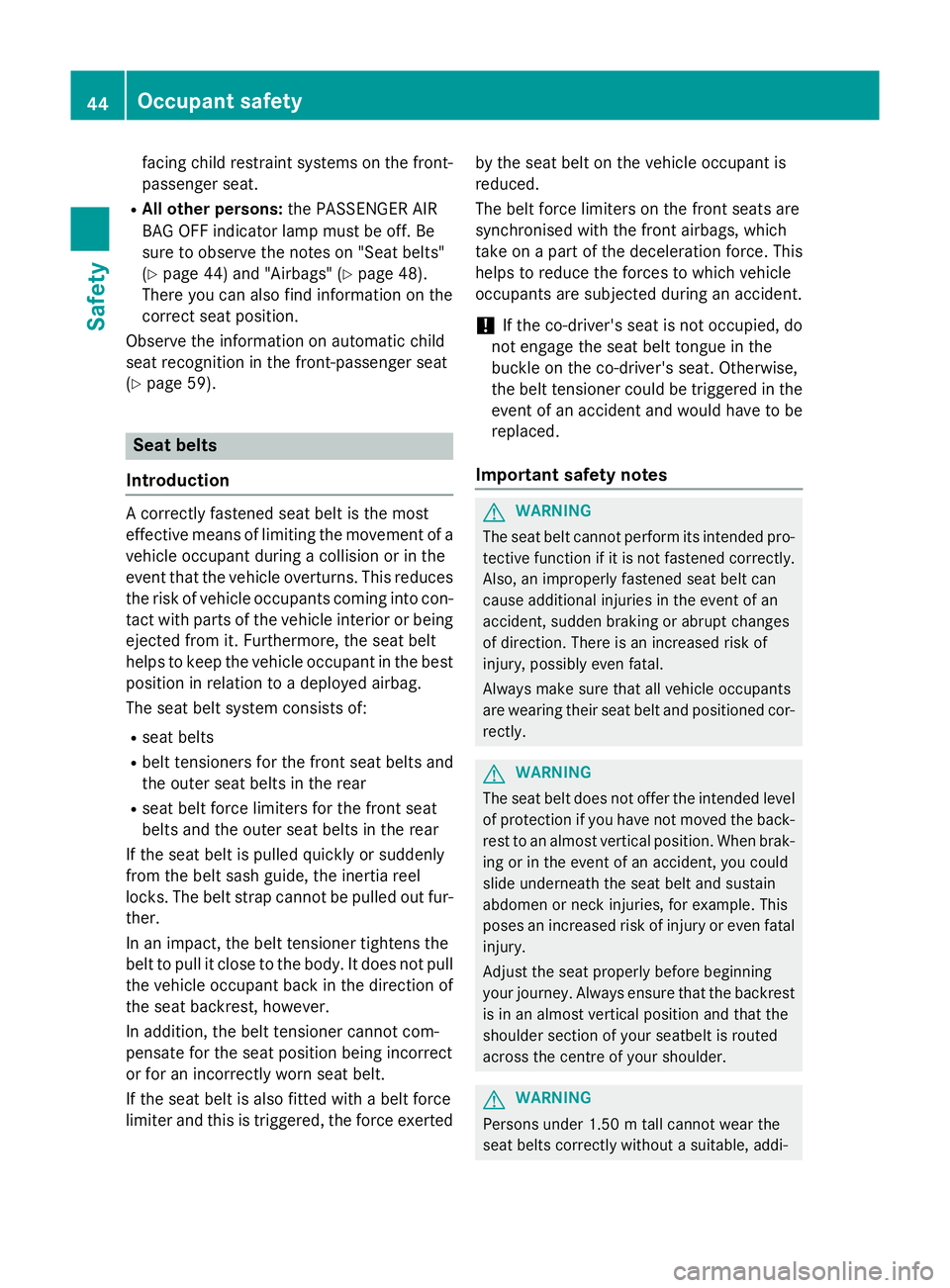
facing child restraint systems on the front-
passenger seat.
R All other persons: the PASSENGER AIR
BAG OFF indicator lamp must be off. Be
sure to observe the notes on "Seat belts"
(Y page 44) and "Airbags" (Y page 48).
There you can also find information on the
correct seat position.
Observe the information on automatic child
seat recognition in the front-passenger seat
(Y page 59). Seat belts
Introduction A correctly fastened seat belt is the most
effective means of limiting the movement of a
vehicle occupant during a collision or in the
event that the vehicle overturns. This reduces
the risk of vehicle occupants coming into con- tact with parts of the vehicle interior or being
ejected from it. Furthermore, the seat belt
helps to keep the vehicle occupant in the best position in relation to a deployed airbag.
The seat belt system consists of:
R seat belts
R belt tensioners for the front seat belts and
the outer seat belts in the rear
R seat belt force limiters for the front seat
belts and the outer seat belts in the rear
If the seat belt is pulled quickly or suddenly
from the belt sash guide, the inertia reel
locks. The belt strap cannot be pulled out fur- ther.
In an impact, the belt tensioner tightens the
belt to pull it close to the body. It does not pullthe vehicle occupant back in the direction of
the seat backrest, however.
In addition, the belt tensioner cannot com-
pensate for the seat position being incorrect
or for an incorrectly worn seat belt.
If the seat belt is also fitted with a belt force
limiter and this is triggered, the force exerted by the seat belt on the vehicle occupant is
reduced.
The belt force limiters on the front seats are
synchronised with the front airbags, which
take on a part of the deceleration force. This
helps to reduce the forces to which vehicle
occupants are subjected during an accident.
! If the co-driver's seat is not occupied, do
not engage the seat belt tongue in the
buckle on the co-driver's seat. Otherwise,
the belt tensioner could be triggered in the
event of an accident and would have to be
replaced.
Important safety notes G
WARNING
The seat belt cannot perform its intended pro- tective function if it is not fastened correctly. Also, an improperly fastened seat belt can
cause additional injuries in the event of an
accident, sudden braking or abrupt changes
of direction. There is an increased risk of
injury, possibly even fatal.
Always make sure that all vehicle occupants
are wearing their seat belt and positioned cor-
rectly. G
WARNING
The seat belt does not offer the intended level of protection if you have not moved the back-
rest to an almost vertical position. When brak-
ing or in the event of an accident, you could
slide underneath the seat belt and sustain
abdomen or neck injuries, for example. This
poses an increased risk of injury or even fatal injury.
Adjust the seat properly before beginning
your journey. Always ensure that the backrest
is in an almost vertical position and that the
shoulder section of your seatbelt is routed
across the centre of your shoulder. G
WARNING
Persons under 1.50 mtall cannot wear the
seat belts correctly without a suitable, addi- 44
Occupant safetySafety
Page 48 of 417
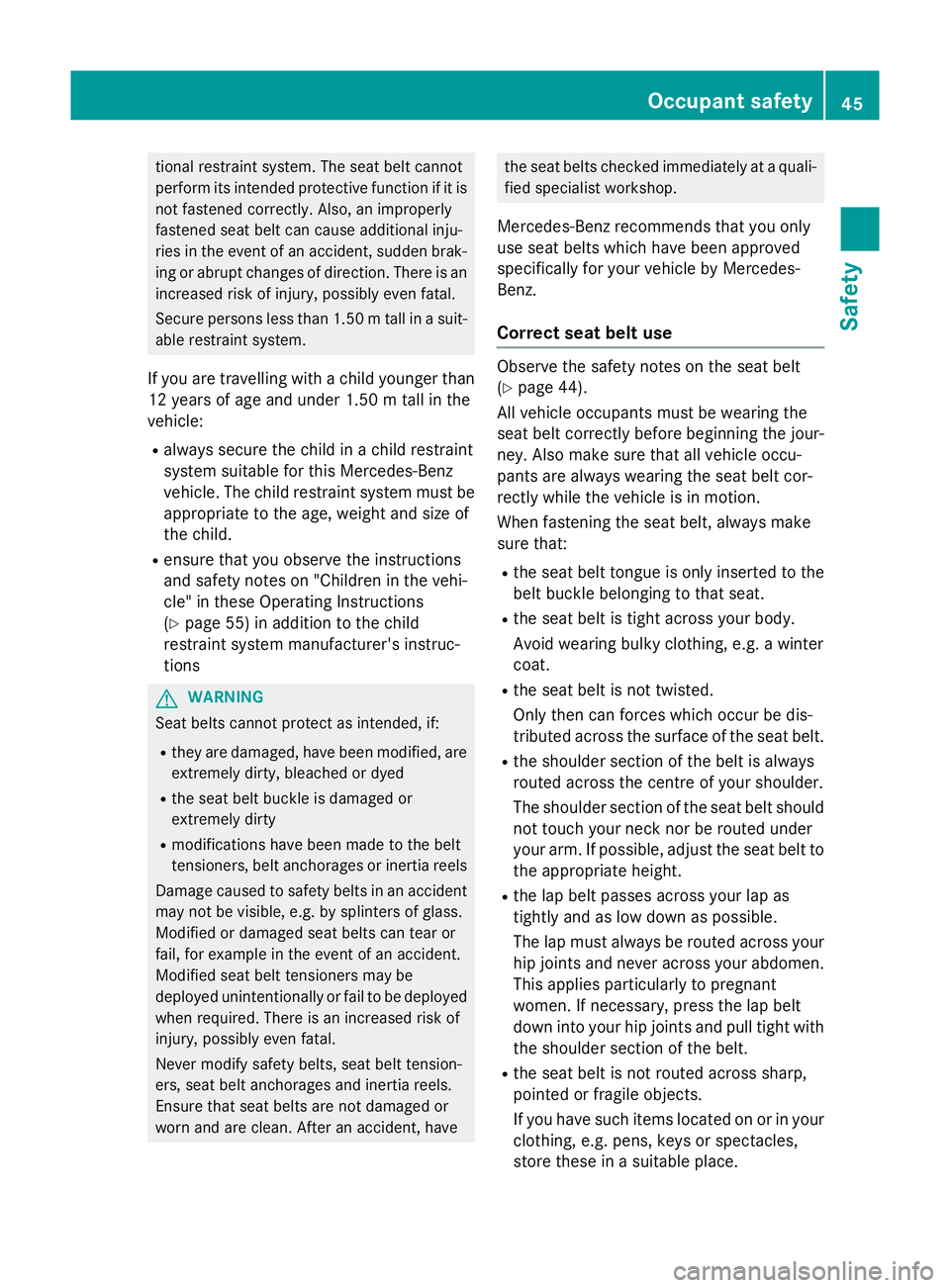
tional restraint system. The seat belt cannot
perform its intended protective function if it is not fastened correctly. Also, an improperly
fastened seat belt can cause additional inju-
ries in the event of an accident, sudden brak-
ing or abrupt changes of direction. There is an increased risk of injury, possibly even fatal.
Secure persons less than 1.50 mtall in a suit-
able restraint system.
If you are travelling with a child younger than
12 years of age and under 1.50 m tall in the
vehicle:
R always secure the child in a child restraint
system suitable for this Mercedes-Benz
vehicle. The child restraint system must be
appropriate to the age, weight and size of
the child.
R ensure that you observe the instructions
and safety notes on "Children in the vehi-
cle" in these Operating Instructions
(Y page 55) in addition to the child
restraint system manufacturer's instruc-
tions G
WARNING
Seat belts cannot protect as intended, if:
R they are damaged, have been modified, are
extremely dirty, bleached or dyed
R the seat belt buckle is damaged or
extremely dirty
R modifications have been made to the belt
tensioners, belt anchorages or inertia reels
Damage caused to safety belts in an accident may not be visible, e.g. by splinters of glass.
Modified or damaged seat belts can tear or
fail, for example in the event of an accident.
Modified seat belt tensioners may be
deployed unintentionally or fail to be deployed
when required. There is an increased risk of
injury, possibly even fatal.
Never modify safety belts, seat belt tension-
ers, seat belt anchorages and inertia reels.
Ensure that seat belts are not damaged or
worn and are clean. After an accident, have the seat belts checked immediately at a quali-
fied specialist workshop.
Mercedes-Benz recommends that you only
use seat belts which have been approved
specifically for your vehicle by Mercedes-
Benz.
Correct seat belt use Observe the safety notes on the seat belt
(Y
page 44).
All vehicle occupants must be wearing the
seat belt correctly before beginning the jour- ney. Also make sure that all vehicle occu-
pants are always wearing the seat belt cor-
rectly while the vehicle is in motion.
When fastening the seat belt, always make
sure that:
R the seat belt tongue is only inserted to the
belt buckle belonging to that seat.
R the seat belt is tight across your body.
Avoid wearing bulky clothing, e.g. a winter
coat.
R the seat belt is not twisted.
Only then can forces which occur be dis-
tributed across the surface of the seat belt.
R the shoulder section of the belt is always
routed across the centre of your shoulder.
The shoulder section of the seat belt should
not touch your neck nor be routed under
your arm. If possible, adjust the seat belt to the appropriate height.
R the lap belt passes across your lap as
tightly and as low down as possible.
The lap must always be routed across your
hip joints and never across your abdomen.This applies particularly to pregnant
women. If necessary, press the lap belt
down into your hip joints and pull tight withthe shoulder section of the belt.
R the seat belt is not routed across sharp,
pointed or fragile objects.
If you have such items located on or in your
clothing, e.g. pens, keys or spectacles,
store these in a suitable place. Occupant safety
45Safety Z
Page 51 of 417
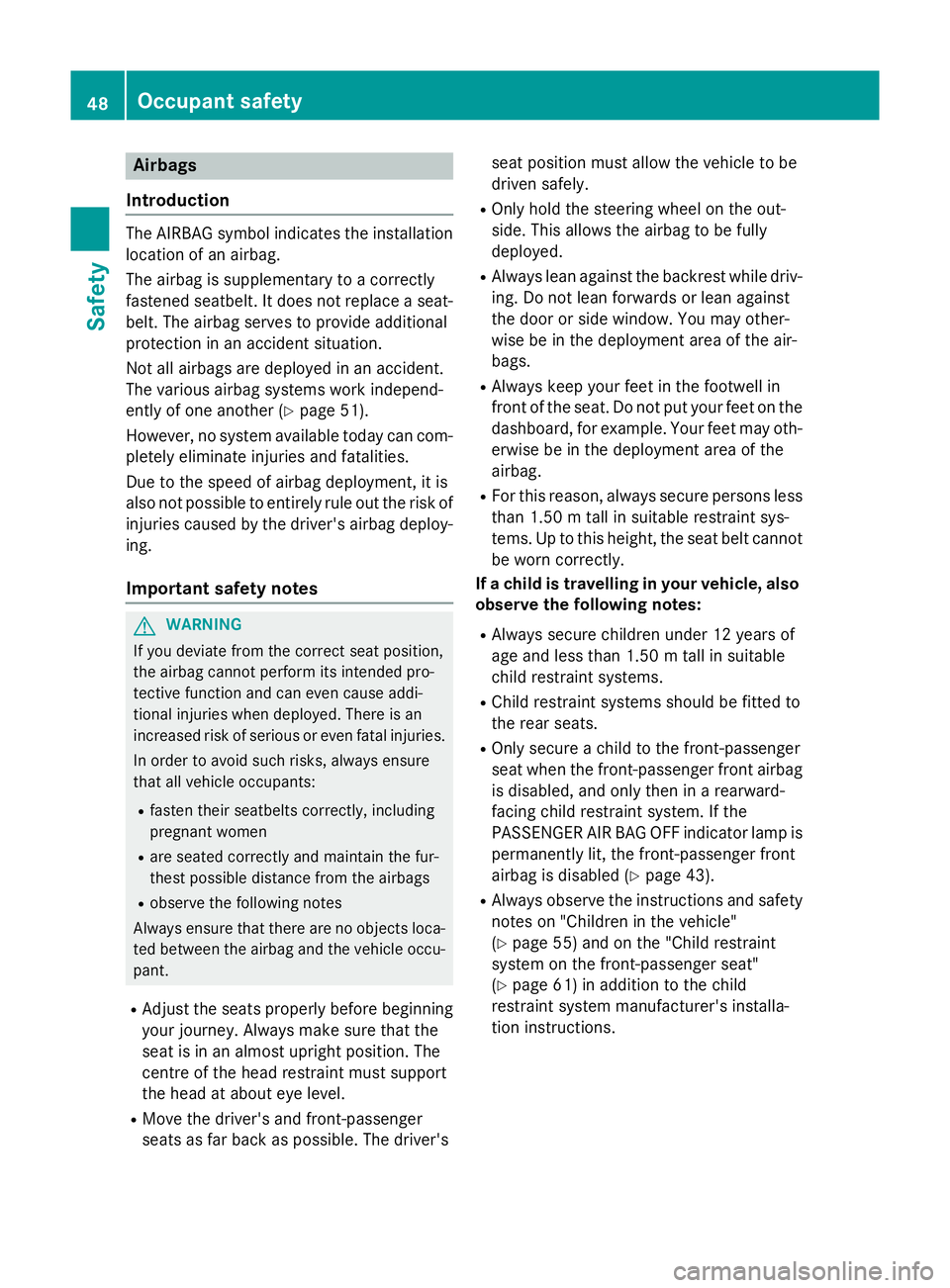
Airbags
Introduction The AIRBAG symbol indicates the installation
location of an airbag.
The airbag is supplementary to a correctly
fastened seatbelt. It does not replace a seat- belt. The airbag serves to provide additional
protection in an accident situation.
Not all airbags are deployed in an accident.
The various airbag systems work independ-
ently of one another (Y page 51).
However, no system available today can com- pletely eliminate injuries and fatalities.
Due to the speed of airbag deployment, it is
also not possible to entirely rule out the risk of
injuries caused by the driver's airbag deploy-
ing.
Important safety notes G
WARNING
If you deviate from the correct seat position,
the airbag cannot perform its intended pro-
tective function and can even cause addi-
tional injuries when deployed. There is an
increased risk of serious or even fatal injuries.
In order to avoid such risks, always ensure
that all vehicle occupants:
R fasten their seatbelts correctly, including
pregnant women
R are seated correctly and maintain the fur-
thest possible distance from the airbags
R observe the following notes
Always ensure that there are no objects loca-
ted between the airbag and the vehicle occu-
pant.
R Adjust the seats properly before beginning
your journey. Always make sure that the
seat is in an almost upright position. The
centre of the head restraint must support
the head at about eye level.
R Move the driver's and front-passenger
seats as far back as possible. The driver's seat position must allow the vehicle to be
driven safely.
R Only hold the steering wheel on the out-
side. This allows the airbag to be fully
deployed.
R Always lean against the backrest while driv-
ing. Do not lean forwards or lean against
the door or side window. You may other-
wise be in the deployment area of the air-
bags.
R Always keep your feet in the footwell in
front of the seat. Do not put your feet on the
dashboard, for example. Your feet may oth-
erwise be in the deployment area of the
airbag.
R For this reason, always secure persons less
than 1.50 mtall in suitable restraint sys-
tems. Up to this height, the seat belt cannot
be worn correctly.
If a child is travelling in your vehicle, also
observe the following notes:
R Always secure children under 12 years of
age and less than 1.50 mtall in suitable
child restraint systems.
R Child restraint systems should be fitted to
the rear seats.
R Only secure a child to the front-passenger
seat when the front-passenger front airbag
is disabled, and only then in a rearward-
facing child restraint system. If the
PASSENGER AIR BAG OFF indicator lamp is
permanently lit, the front-passenger front
airbag is disabled (Y page 43).
R Always observe the instructions and safety
notes on "Children in the vehicle"
(Y page 55) and on the "Child restraint
system on the front-passenger seat"
(Y page 61) in addition to the child
restraint system manufacturer's installa-
tion instructions. 48
Occupant safetySafety